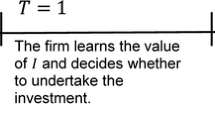Abstract
In this paper we use a cost-effectiveness framework to model the strategic decision-making considerations by pharmaceutical manufacturers as they relate to drug development and the new technology of PG (the science of using genetic markers to predict drug response).
In a simple, static, one-period model we consider three drug development strategies: a drug is exclusively developed and marketed to patients with a particular genetic marker; no distinguishing among patients based on the expression of a genetic marker is made (traditional approach); and a strategy whereby a drug is marketed to patients both with and without the genetic marker but there is price discrimination between the two subpopulations.
We developed three main principles: revenues under a strategy targeting only the responder subpopulation will never generate more revenue than that which could have been obtained under a traditional approach; total revenues under a targeted PG strategy will be less than that under a traditional approach but higher than a naïve view would believe them to be; and a traditional approach will earn the same total revenues as a price discrimination strategy, assuming no intermarket arbitrage.
While these principles relate to the singular (and quite narrow) consideration of drug revenues, they may nevertheless partially explain why PG is not being used as widely as was predicted several years ago when the technology first became available, especially in terms of pharmaceutical manufacturer-developed tests.




Similar content being viewed by others
Notes
The use of trade names is for product identification purposes only and does not imply endorsement.
Strategy 3 is not likely to be a viable strategy. We have included it for the purpose of demonstrating a key finding from the model and analysis. Namely, we will show that pricing based on the average population response (i.e. pricing under strategy 2) and differential pricing based on sub-group responses (i.e. pricing under strategy 3) result in an identical outcome, at least insofar as revenues in our model are determined.
It is possible to think of p 1 as the price of the product bundle that comprises the drug and the PG test.
The construction of the model assumes q is exogenous, and not a function of p. This could easily be modified, but doing so will not affect the principles derived or the qualitative results. This assumption of inelastic demand is common in the CEA literature. Vernon et al.[10] discuss the rationales found in the literature for this modelling assumption.
References
Bhandari M, Garg R, Glassman R, et al. The phannacogenomics challenge: the only option is how and when you participate. In Vivo 1999; 17 (3): 36–41
Med Ad News, May 2005 from Pharmlive.com special reports [online]. Available from URL: http://www.pharmalive.com-special_reports-sample.cfmreportID=191 [Accessed 2005 Jul 19]
Eisenberg JM. Clinical economics: a guide to the economic analysis of clinical practices. JAMA 1989; 262 (20): 2879–2886
Sloan F, editor. Valuing health care. 2nd ed. Carmridge: Cambridge University Press, 1995
Drummond MF, O’Brien BJ, Stoddart GL, et al. Methods for the economic evaluation of health care programmes. New York: Oxford University Press, 1997
Jommi C. Pharmaceutical policy and organisation of the regulatory authorities in the main EU countries. Cergas: Egea Publishing, 2001
Gosling H. European pharmacoeconomics: the fourth hurdle, global pharmaceutical reports. New York: SMi Publishing, 2000
Atkinson T. The global parallel trade outlook 2001–2006: a country-by-country analysis. London: REUTERS Business Insights, 2001
Danzon P, Towse A. The economics of gene therapy and pharmacogenetics. Value Health 2002; 5 (1): 5–13
Vernon JA, Hughen WK, Johnson SJ. Mathematical modeling and pharmaceutical pricing: analyses used to inform in-licensing and developmental go/no-godecisions. Health Care Manag Sci 2005; 8 (2): 167–179
Miller P. Role of pharmacoeconomic analysis in R&D decision making: when, where, how? Pharmacoeconomics 2005; 23 (1), 1–12
Acknowledgements
We are indebted to the Pfizer Inc. Global Steering Committee on Pharmacogenomic Technology for numerous comments, suggestions and discussions regarding this research. In particular, Patrice Milos, Adian Power and Jack McMillan provided us with invaluable assistance and support. We also wish to thank Henry Grabowski and John M. Vernon of Duke University, Michael Grossman of the NBER, Bob Goldberg of the Manhattan Institute and four anonymous referees for their very helpful comments. All remaining errors are our own.
The authors have no conflicts of interest that are directly relevant to the content of this article. No sources of funding were used in the preparation of this article.
Author information
Authors and Affiliations
Corresponding author
Rights and permissions
About this article
Cite this article
Vernon, J.A., Johnson, S.J., Hughen, W.K. et al. Economic and Developmental Considerations for Pharmacogenomic Technology. Pharmacoeconomics 24, 335–343 (2006). https://doi.org/10.2165/00019053-200624040-00004
Published:
Issue Date:
DOI: https://doi.org/10.2165/00019053-200624040-00004




